"Most Loadhaul Class 60s remained either in full Trainload livery, or had the Trainload decals removed to render an unbranded triple-grey look."

Battling the Arctic-style conditions of New Year's Day 2002, 60034 flies the flag for Transrail grey livery.
With thanks to those who shared links to my Class 60 article last week, I'm making this payback time. Yes, I've dug deep into my photo archives to bring forth another selection of visual Class 60 studies - mainly from the long-lost era of film.
The theme this time is an exploration of the standard Class 60 aesthetics that sat across the transitional period from late British Rail into early privatisation. Did you know that the first Class 60 EWS repainted was not initially released in red and gold? Did you know that the 60s have a "clean end" and a "dirty end"? Have you ever wondered why so many 60s were stripped of their original nameplates in the 1990s? If not, don't worry. It's all coming up in this very post. And if you're just here for the nostalgic images, there's plenty here that the world has never before seen...
STANDARD CLASS 60 LIVERY VARIATIONS

60091 brazens out a rather grubby Trainload Coal livery, at Bromsgrove.
I covered some of the earlier livery exceptions in the previous post, but here I'm going to make sense of the standard livery assortment as the railway went into privatisation. I'll be providing a full livery snapshot list later in the article, covering all members of the class, but first let's set out the terminology and timeline...

Above, you can see 60068 wearing a generic, unbranded version of British Rail's triple-grey livery, at Barnt Green. This was not the loco's original aesthetic state. It was what remained after the original Trainload sector markings were removed. However, this raw base livery without any branding does give us a starting point for discussion about all variants of BR triple-grey.
All Class 60s wore the triple-grey base livery up until the pre-privatisation phase, which commenced in 1994. Because of the way light would fall onto the locos, dirt amassing on the roof, and the angle of view, it could sometimes be hard to discern all three shades of grey. The first shade occupied the bottom half of the bodyside and was the lightest. The next shade - mid grey - occupied the top half of the bodyside and the lead-in to the roof. The final shade - darkest of the three - occupied the main portion of the roof.

60021 was another member of the unbranded BR triple-grey club. It's seen here in March 2001 with a loaded coal departure in Washwood Heath Yard - accompanied by Bescot-based yard helper, 08884 in the much longer-established livery of Rail Blue.
British Rail's original triple-grey livery went a long way for the Class 60 in the minor update stakes, and had different terms of reference depending on the branding.
The triple-grey livery itself was designated in the spotting books as "Railfreight", or "new Railfreight", to differentiate it from the earlier large logo or 'red stripe' Railfreight liveries of the mid 1980s. "Railfreight" was the parent term for the triple-grey colour scheme.
However, once you put Trainload decals on it (and all Class 60s originally carried Trainload decals), the same livery's term of reference would, in most enthusists' vocab, change to "Trainload", followed by the sector name. For example, "Trainload Coal" for triple-grey with Coal sector decals, or "Trainload Petroleum" for triple-grey with Petroleum sector decals. Some people would still refer to the livery of a triple-grey loco with Trainload decals as "Railfreight", and there's nothing incorrect about that, because Railfreight is still the parent livery.

60054 Charles Babbage is seen above, near Norton Junction, in Trainload Petroleum livery. It's exactly the same as unbranded triple-grey (or unbranded "Railfreight grey"), but with blue and yellow Petroleum ID decals. The large decal on the upper bodyside is accompanied by a smaller, vertical strip-form version behind the leading cab door.
Although the Class 60s originally only wore Trainload decals - namely Coal, Construction, Metals and Petroleum - the small-scale Class 60 model exhibited by Brush as a preview in the late 1980s actually had red and yellow Railfreight General decals. Had any 60s actually worn those decals in real life, their triple-grey livery would have been described as Railfreight General - not Trainload. The decals were dictating the name of the livery.
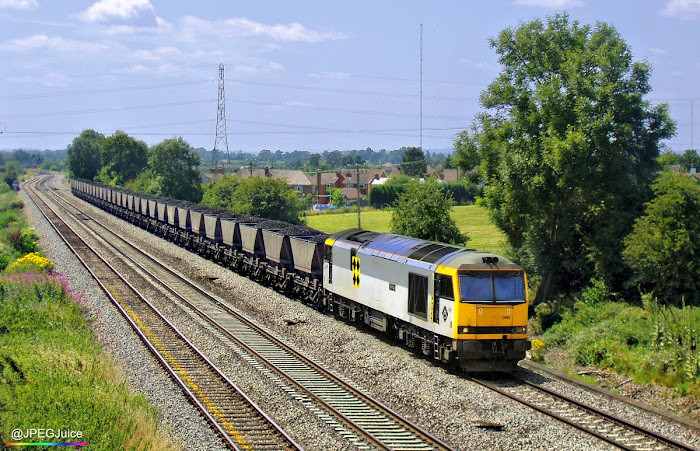
60090 makes a nice representation of "Trainload Coal" livery, complete with a loaded coal train, in the picture above. Only the type of decals differentiates this Trainload Coal livery from Trainload Petroleum. The plaque on the leading cabside is an Immingham depot plate.
When BR split Trainload down into three pre-privatisation freight businesses in 1994, the majority of the 60s retained the same base livery - which was still almost new at the time. The new pre-privatisation branding frequently replaced the old Trainload decals - but not always. Many Class 60s never saw any pre-priv branding at all.

When they were rebranded, however, the amended versions of the triple-grey livery were no longer known as "Trainload". They were instead commonly referenced with the pre-priv business name as a prefix to the word "grey". So "Transrail grey", "Mainline grey", or "Loadhaul grey". Above, 60100 sports "Mainline grey" on the ever-memorable 6V70 Cliffe Vale - St Blazey china clay empties, at Northfield, on 11th December 2001.
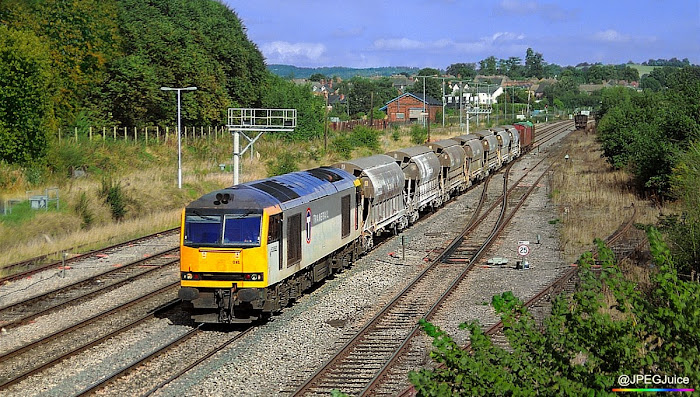
Unlike Mainline and Loadhaul, Transrail never developed a separate livery of its own, so no Transrail 60s lost their triple-grey until after British Rail had relinquished the locos to EWS. Again, working the 6V70 - this time on 22nd September 2000 - "Transrail grey" 60082 shows how perfect the timing of this train was for sunlighting on the B&G line, passing Bromsgrove in its booked path at around 12:15. This loco lacked the two red underscores beneath its "T" logo on this side, but not on the other. It was common for 60s to lose Transrail underscores, but don't worry - you'll see the underscores shortly.

And in "Loadhaul grey", 60064 completes the pre-priv grey example appearances on the 6V70 - this instance having been recorded at Northfield on 22nd October 2001. Loadhaul was by far the least disposed of the three pre-priv businesses to branding its grey locos. Indeed initially, it didn't always brand its Loadhaul liveried locos. Hence, most Loadhaul Class 60s remained either in full Trainload livery, or had the Trainload decals removed to render an unbranded triple-grey look. Branded "Loadhaul grey" Tugs were thus an unusual sight.
Loadhaul repainted five Class 60s in a striking black and orange livery that became highly chaseable for photographs - even more so after the locos broke with their confinement to workings based out of north-east England, and went systemwide with EWS. The first of the Loadhaul Class 60 repaints wasn't outshopped until mid 1995 - only eight months before sale of the business to the embryonic EWS. The fact that the Loadhaul black/orange beasties were painted more recently than the original grey locos helped them evade the EWS livery in the early years of privatisation.

60007, illustrated above coming off the bottom of the Lickey at St Godwalds, was one of the Loadhaul machines whose livery survived long enough to later receive an EWS bodyside vinyl in place of the old Loadhaul branding.
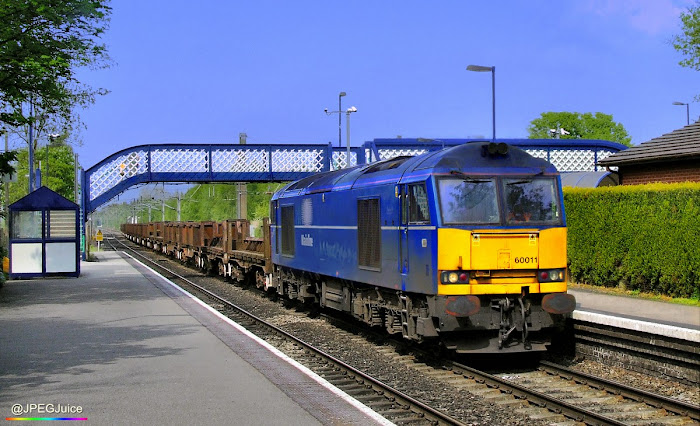
Mainline Freight repainted just three Class 60s in its aircraft blue livery, which you can see on 60011 above. Although the rich colour was eyecatching, the livery design was basic - no match for Loadhaul black and orange in terms of design flair. But with that said, Rail Blue was even more basic and became one of the most iconic modern traction liveries ever. Mainline blue was popular on the 60s - in part, one suspects, due to the scarcity of examples with this look. Proportionally, the Mainline blue Tugs were even more persistent survivors than the Loadhaul jobs.
BEFORE AND AFTER
To show the transition from British Rail livery to EWS livery, here are a couple of before and after sequences...
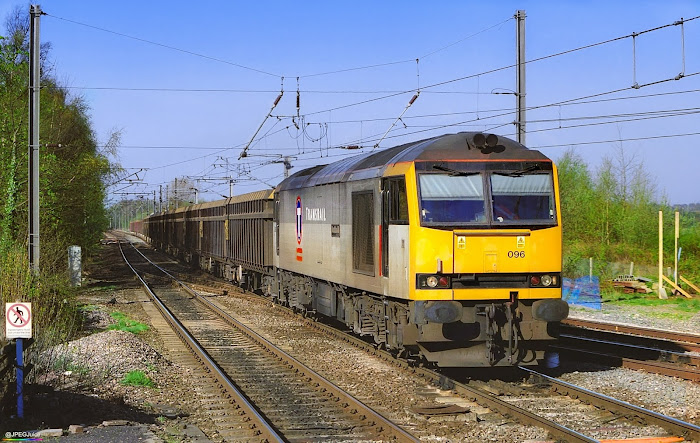
Working the Saltley to Cardiff Tidal scrap metal train through Barnt Green on Friday 9th April 1999 - the first really warm evening of the year in Birmingham - 60096 is still carrying its original Ben Macdui nameplates, as fitted in May 1992. And you can now see the red underscores that went beneath the Transrail "T" logo.
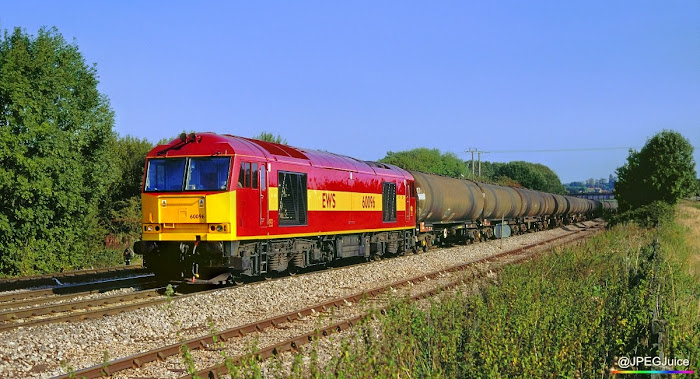
The same loco would emerge unnamed in EWS red livery in September 2002, and is seen above on the 25th of the month at Aston Fields. The train is the Wednesdays only Port Clarence to Westerleigh oil tanks. Later in the decade, the Port Clarence - Westerleigh and return would haul a rake of highly photogenic red Petroplus tanks, but the motive power was very typically a 66 by then.

This "before" shot of 60065 in Transrail grey near Walsall on 4th July 2001, has an interesting detail. When the 60s were rebranded by the pre-priv businesses, the bodyside portions of their Trainload decals were removed, but the top of the main decal overlapped onto the roof, and numerous examples retained the overlap. Above the Transrail "T" logo, you can see the blue roof overlap of 60065's Petroleum sector decal. You could often tell which locos had formerly been with Trainload Coal, as their roof overlap, if left in situ, was black rather than blue.
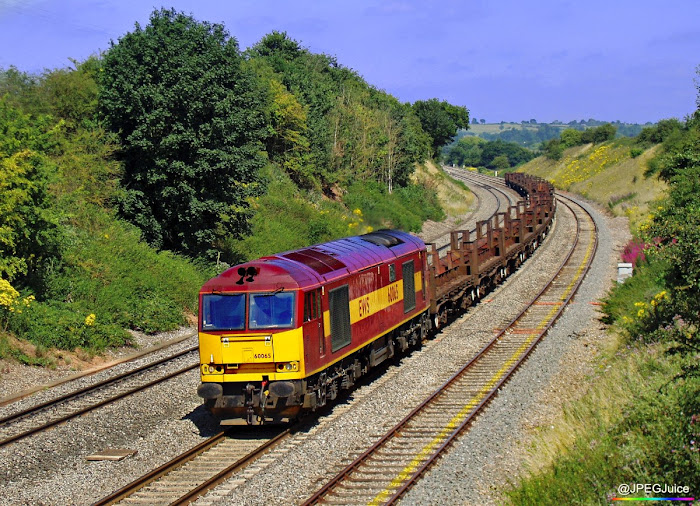
And at Stoke Prior in summer 2005, the same locomotive now sports EWS red.
"CLEAN END", "DIRTY END"

If you're a photographer who seeks optimum aesthetics, you probably quite quickly noticed that the Tugs have a "clean end" and a "dirty end". The No. 2 end houses the exhaust outlet, which will progressively cake the No. 2 cab top black when the No.1 end leads. If the loco is approaching with the No.1 end leading, the cab top will often be relatively clean. If it's running No.2 end first, you typically get a grubbier shot, with the effect you see above on 60048, at Defford. The red on the cab top is almost totally concealed by the exhaust residue.

Here's the "dirty end" of Loadhaul liveried 60038, as the loco descends Hatton Bank, No. 2 cab first. Compare the look of this cab top with that of Loadhaul 60007, further up the post.
CLASS 60 LIVERIES - FULL FLEET CIRCA APRIL 1999
The list below shows the progress made by EWS in repainting the fleet in the first three years of privatised operation, whilst also retaining an encapsulation of the mix that had prevailed in the final days of pre-privatised British Rail.

60021 in the updated version of EWS red livery. See higher up the post for the same loco in earlier triple-grey.
A quick key for the EWS red locos before we start...
"+" = Original "EW&S"-branded livery with no cabside animal emblem, default until autumn 1996.
"-" = Updated version of the red and gold livery, with "EWS" branding and cabside animal emblem, default post-autumn 1996.
Here's the list. All Class 60 liveries as of April 1999...
EWS red: 60001-, 60002+, 60003-, 60004-, 60005-, 60010+, 60012+, 60016-, 60017+, 60018-, 60019+, 60020+, 60022-, 60023-, 60024+, 60026+, 60027-, 60029-, 60030-, 60036-, 60037-, 60039-, 60040+, 60041+, 60045-, 60047+, 60048-, 60049+, 60050+, 60051-, 60052-, 60053-, 60083-, 60098+.
Unbranded triple-grey: 60013, 60021, 60028, 60046, 60067, 60068, 60069, 60095.
Transrail grey: 60015, 60032, 60034, 60035, 60055, 60056, 60058, 60061, 60062, 60063, 60065, 60080, 60081, 60082, 60084, 60085, 60089, 60092, 60093, 60096, 60097.
Mainline grey: 60042, 60071, 60072, 60073, 60074, 60075, 60076, 60077, 60079, 60086, 60087, 60088, 60094, 60099, 60100.
Mainline Blue: 60011, 60044, 60078.
Loadhaul black: 60007, 60008, 60025, 60038, 60059.
Loadhaul grey: 60064, 60070.
British Steel Blue: 60006, 60033.
Trainload Coal: 60057, 60060, 60090, 60091.
Trainload Construction: 60043.
Trainload Metals: 60009, 60031.
Trainload Petroleum: 60014, 60054.
Transrail / "Transrail Coal": 60066 - see below.

60066 wore a unique combination of Trainload Coal decals and Transrail branding on one side only. On the other side it carried the regular Transrail logo. I've listed its livery as Transrail / "Transrail Coal". It's caught in action above, on the Cliffe Vale - St Blazey china clay empties of 31st May 2000, with the odd branding/decal combination in view.
There are some notable points to be drawn from the list. For example, the way the EWS red candidates are very predominantly contained within the first half of the numerical fleet list. And the survival of ten examples with original Trainload markings, although 60066 also had newer Transrail markings. Then there's a rather significant total of eight 60s in the unbranded version of triple-grey, versus just two in branded Loadhaul grey. All of the Loadhaul black and Mainline blue examples have managed to evade a visit to the paint shop.
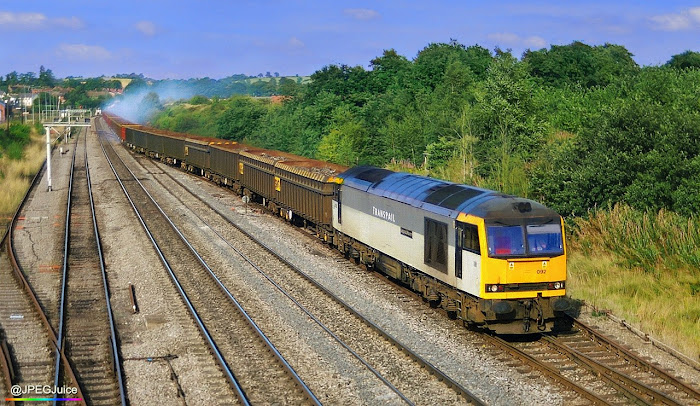
Although 60092 was listed in Transrail grey, it did not have a logo on the side depicted above. Although people often reference the Tugs' great capability in starting massive loads, braking those long, heavy trains relies on other factors besides the loco. On 6th September 2000, aggressively taking the momentum of a Lickey descent out of the Saltley to Cardiff Tidal scrap metal train, in order to access the Bromsgrove passing loop, has clearly not met with the approval of all wagons. Most spotting experiences are a sight and sound. This one was a sight, a sound, and a smell.
EARLIEST REPAINTS
The very first Class 60 repainted by EWS did not initially receive the red livery, as the loco was repainted under the North and South Railways brand in March 1996 and the EW&S aesthetic was not finalised until the following month. EWS / North and South refused to outshop any locos in a British Rail livery at this stage, and therefore, 60022 was outshopped in white undercoat but with a gloss clear coat on top and full yellow ends.
I never photographed 60022 in white, but there's a shot of it on this external page.
This very temporary 'livery', peculiar to Immingham stock, was applied to fewer than ten other locos (from Classes 37, 56 and 58), and became known as 'Ghost livery'. Most recipients were fairly swiftly revised into EW&S red once it was introduced, but 56068 - the last surviving 'ghost' - managed to evade recapture until the end of summer 1997.
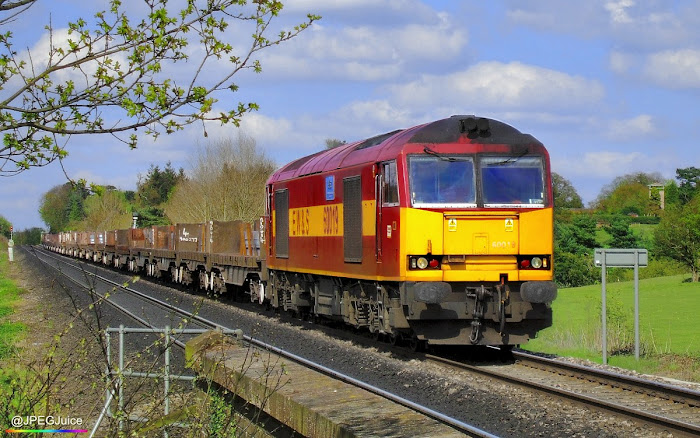
The first actual red and gold 60 was 60019, which emerged a couple of months after the white 'ghost' job. Note, in the picture above, how '019's gold bodyside base strip loops right round onto the base of the cab front - very proto. And clock the mini Loadhaul sticker on the leading cabside. The height of the fleet number and branding was greater on the first version of the red and gold livery than on the version used post October 1996.
Despite the vow not to dip another brush into a pot of BR paint, it appears that EWS later at least refreshed some of the BR paintwork on the odd triple-grey 60 here and there. Most notable was the instance below, in which I photographed 60084 on the Corby - Margam steel empties at Washwood Heath Yard on 27th April 2006...
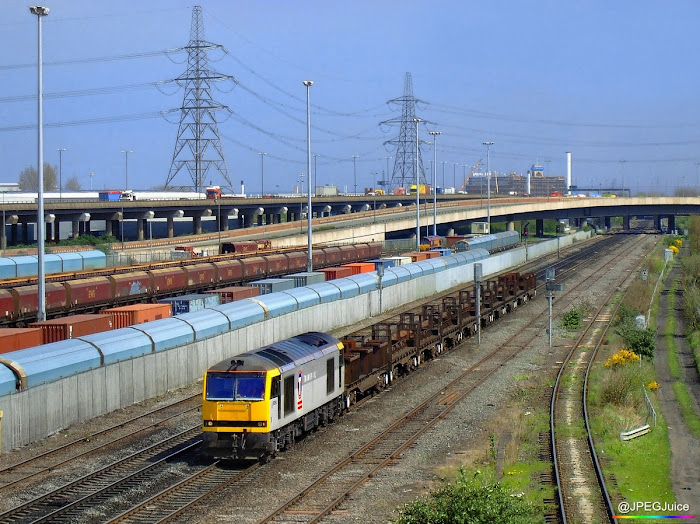
Clearly, that loco has not gone without any repainting for more than ten years. Other locos in the early privatised era - very particularly some Virgin 86s - also appeared to have been quietly turned out of paint shops in BR liveries rather than the current operator's colours. The probable explanation was that the works scheduled only a minor touch-up, then for whatever reason upgraded the job to a more extensive repaint part way through.
BR LIVERIES WITH EWS BRANDING

In 2005, EWS finally realised that nearly a decade in, nowhere near covering the whole fleet with house colours, and with the future use of individual locos highly fluid, it would make sense to run up some easy-apply bodyside branding. The first vinyls were applied to remnant locos from the Railfreight grey unbranded group, and had the same vertical dimensions as the bodyside grilles. On 12th September 2005, 60046 shows the early format on a trip through Tipton, into Wolverhampton Steel Terminal.

But the next batch of stick-ons were enlarged to full bodyside height, and progressively applied to most other BR-liveried 60s. Gladly, surviving Trainload slogger 60054 managed to avoid the desecration its Petroleum sector decals. But the remaining Loadhaul black and Mainline blue locos did not put up universal resistance. A shame in terms of historical value, but the full-sized, maroon on yellow actually suited the dark-coloured British Rail 60s pretty well. Unfortunately, the removal of the light grey bodyside stripes on all of the Mainline blue jobs was far from neat, although the stripes were already getting patchy by the mid 2000s.

Some triple-grey machines also received larger cab front numbers roughly concurrent with the branding roll-out. You can see the result above on 60076.
NAMEPLATE INVESTIGATION
If you've ever wondered why so many Class 60s were de-named in the 1990s, the answer, at least in part, is that their original 'Peak' nameplates were a leading target for thieves. In 2000, the British Transport Police issued a list of nameplates they believed to have been stolen during the 1990s, including reference to no fewer than 36 Class 60s - the highest number of locos from any class on the list. The number of 60s whose original nameplates were removed is a lot higher than 36, however.
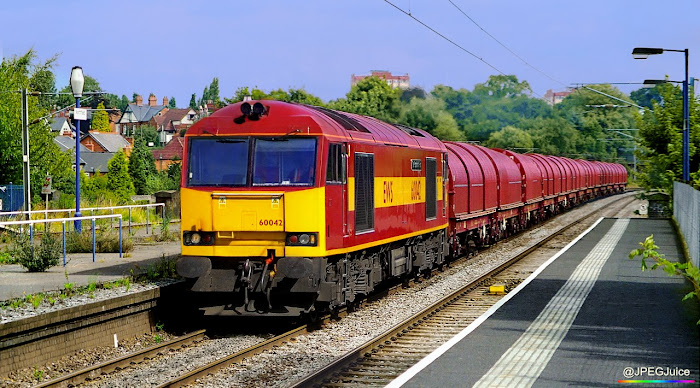
Fresh after being named The Hundred of Hoo in summer 1999, 60042 looks like a true EWS brand ambassador with the Toton - Round Oak steel, at Northfield. The repaint went with the naming, and saw the loco lose its previous Mainline grey, as well as its original Dunkery Beacon nameplates from May 1991.
Some plates were removed shortly before or at the time of EWS repaint - or indeed Loadhaul repaint. 24 Class 60s lost their original plates in 1996, and 27 lost them in 1997. If you actually go through the list of de-naming dates, you see a similar pattern among the '96 and '97 name removals to that of the repaint list. That is, like the EWS repaints, the great majority of '96 and '97 de-namings appear within the first half of the numerical fleet list.
To me, more of the de-namings look like operator decisions than thefts, but the police list didn't specify whether one or both plates from each loco had gone missing, or whether they'd initially been replaced and then subsequently de-named for another reason. When publishing the list in 2000, Rail Express magazine questioned its accuracy, but it's fair to conclude that some 60s did lose nameplates to thieves.

60083 lost its original Shining Tor plates in March 1997 when it had its EWS red repaint. It emerged unnamed, but was given the new name Mountsorrel at the Toton Open Weekend on 30th August 1998. I can't confirm, but 60083 Mountsorrel looked suspiciously like the Lickey Banker on the snowy day depicted above. Significant if it was, because I took this shot at Northfield on 29th January 2004, which was after the duty had switched to Class 66 power. Assuming this was the banker heading from Saltley to Bromsgrove (and the timing of dispatch was right to meet the Ironbridge coal, so it's very likely), I'd bet that the weather conditions and the choice of loco type were not a coincidence.
OUT WITH THE OLD, IN WITH THE NEW

Although the transition away from the British Rail image was far from over with the end of EWS, successor DB Schenker would progressively filter the aesthetics of the active fleet down to something much more modern. But the dawn of this new era began with a one-off livery, highly reminiscent of the British Steel blue 60s of the late 1990s. Above, on 4th March 2008, former Mainline grey wallflower 60074 turns up in its new guise as Teenage Spirit. This Westerleigh to Lindsey journey was one of its first runs after an initial period of static display. Even the "dirty end" is spotless.
The future was taking shape, and we quckly began to realise that the triple-grey livery we'd so long taken for granted, was now very much the nostalgia of tomorrow...
